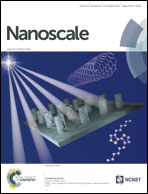Architecture engineering toward highly active palladium integrated titanium dioxide yolk–double-shell nanoreactor for catalytic applications†
Abstract
Rational design of the hierarchical architecture of a material with well controlled functionality is crucially important for improving its properties. In this paper, we present the general strategies for rationally designing and constructing three types of hierarchical Pd integrated TiO2 double-shell architectures, i.e. yolk–double-shell TiO2 architecture (Pd@TiO2/Pd@TiO2) with yolk-type Pd nanoparticles residing inside the central cavity of the hollow TiO2 structure; ultrafine Pd nanoparticles homogenously dispersed on both the external and internal surfaces of the inner TiO2 shell; and double-shell TiO2 architecture (@TiO2/Pd@TiO2) with Pd nanoparticles solely loaded on the external surface of the inner TiO2 shell, and double-shell TiO2 architecture (@TiO2@Pd@TiO2) with Pd nanoparticles dispersed in the interlayer space of double TiO2 shells, via newly developed Pd2+ ion-diffusion and Pd sol impregnation methodologies. These architectures are well controlled in structure, size, morphology, and configuration with Pd nanoparticles existing in various locations. Owing to the variable synergistic effects arising from the location discrepancies of Pd nanoparticle in the architectures, they exhibit remarkable variations in catalytic activity. In particular, different from previously reported yolk–shell structures, the obtained yolk–double-shell Pd@TiO2/Pd@TiO2 architecture, which is revealed for the first time, possesses a uniform hierarchical structure, narrow size distribution, and good monodispersibility, and it creates two Pd–TiO2 interfaces on the external and internal surfaces of the inner TiO2 shell, leading to the strongest synergistic effect of Pd nanoparticles with TiO2 shell. Furthermore, the interlayer chamber between the double TiO2 shells connecting with the central cavity of the hollow TiO2 structure through the mesoporous TiO2 wall forms a nanoreactor for enriching the reactants and preventing the deletion of Pd nanoparticles during the reaction, thus greatly accelerating the reaction speed. Owing to its structural features, yolk–double-shell Pd@TiO2/Pd@TiO2 architecture exhibits extremely high catalytic performance on the Suzuki–Miyaura coupling reaction. The synthetic methodologies are robust for fabricating double-shell architectures with various configurations for applications such as in catalysis, drug delivery, and medicine release. The obtained double-shell architectures may be used as novel catalyst systems with highly efficient catalytic performance for other catalytic reactions.


 Please wait while we load your content...
Please wait while we load your content...